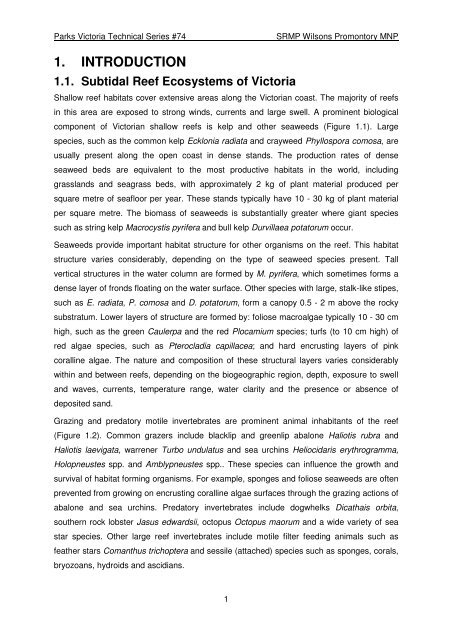the reef biota at Wilsons promontory marine national - Parks Victoria
the reef biota at Wilsons promontory marine national - Parks Victoria
the reef biota at Wilsons promontory marine national - Parks Victoria
- No tags were found...
Create successful ePaper yourself
Turn your PDF publications into a flip-book with our unique Google optimized e-Paper software.
<strong>Parks</strong> <strong>Victoria</strong> Technical Series #74SRMP <strong>Wilsons</strong> Promontory MNP1. INTRODUCTION1.1. Subtidal Reef Ecosystems of <strong>Victoria</strong>Shallow <strong>reef</strong> habit<strong>at</strong>s cover extensive areas along <strong>the</strong> <strong>Victoria</strong>n coast. The majority of <strong>reef</strong>sin this area are exposed to strong winds, currents and large swell. A prominent biologicalcomponent of <strong>Victoria</strong>n shallow <strong>reef</strong>s is kelp and o<strong>the</strong>r seaweeds (Figure 1.1). Largespecies, such as <strong>the</strong> common kelp Ecklonia radi<strong>at</strong>a and crayweed Phyllospora comosa, areusually present along <strong>the</strong> open coast in dense stands. The production r<strong>at</strong>es of denseseaweed beds are equivalent to <strong>the</strong> most productive habit<strong>at</strong>s in <strong>the</strong> world, includinggrasslands and seagrass beds, with approxim<strong>at</strong>ely 2 kg of plant m<strong>at</strong>erial produced persquare metre of seafloor per year. These stands typically have 10 - 30 kg of plant m<strong>at</strong>erialper square metre. The biomass of seaweeds is substantially gre<strong>at</strong>er where giant speciessuch as string kelp Macrocystis pyrifera and bull kelp Durvillaea pot<strong>at</strong>orum occur.Seaweeds provide important habit<strong>at</strong> structure for o<strong>the</strong>r organisms on <strong>the</strong> <strong>reef</strong>. This habit<strong>at</strong>structure varies considerably, depending on <strong>the</strong> type of seaweed species present. Tallvertical structures in <strong>the</strong> w<strong>at</strong>er column are formed by M. pyrifera, which sometimes forms adense layer of fronds flo<strong>at</strong>ing on <strong>the</strong> w<strong>at</strong>er surface. O<strong>the</strong>r species with large, stalk-like stipes,such as E. radi<strong>at</strong>a, P. comosa and D. pot<strong>at</strong>orum, form a canopy 0.5 - 2 m above <strong>the</strong> rockysubstr<strong>at</strong>um. Lower layers of structure are formed by: foliose macroalgae typically 10 - 30 cmhigh, such as <strong>the</strong> green Caulerpa and <strong>the</strong> red Plocamium species; turfs (to 10 cm high) ofred algae species, such as Pterocladia capillacea; and hard encrusting layers of pinkcoralline algae. The n<strong>at</strong>ure and composition of <strong>the</strong>se structural layers varies considerablywithin and between <strong>reef</strong>s, depending on <strong>the</strong> biogeographic region, depth, exposure to swelland waves, currents, temper<strong>at</strong>ure range, w<strong>at</strong>er clarity and <strong>the</strong> presence or absence ofdeposited sand.Grazing and pred<strong>at</strong>ory motile invertebr<strong>at</strong>es are prominent animal inhabitants of <strong>the</strong> <strong>reef</strong>(Figure 1.2). Common grazers include blacklip and greenlip abalone Haliotis rubra andHaliotis laevig<strong>at</strong>a, warrener Turbo undul<strong>at</strong>us and sea urchins Heliocidaris erythrogramma,Holopneustes spp. and Amblypneustes spp.. These species can influence <strong>the</strong> growth andsurvival of habit<strong>at</strong> forming organisms. For example, sponges and foliose seaweeds are oftenprevented from growing on encrusting coralline algae surfaces through <strong>the</strong> grazing actions ofabalone and sea urchins. Pred<strong>at</strong>ory invertebr<strong>at</strong>es include dogwhelks Dic<strong>at</strong>hais orbita,sou<strong>the</strong>rn rock lobster Jasus edwardsii, octopus Octopus maorum and a wide variety of seastar species. O<strong>the</strong>r large <strong>reef</strong> invertebr<strong>at</strong>es include motile filter feeding animals such asfea<strong>the</strong>r stars Comanthus trichoptera and sessile (<strong>at</strong>tached) species such as sponges, corals,bryozoans, hydroids and ascidians.1

















